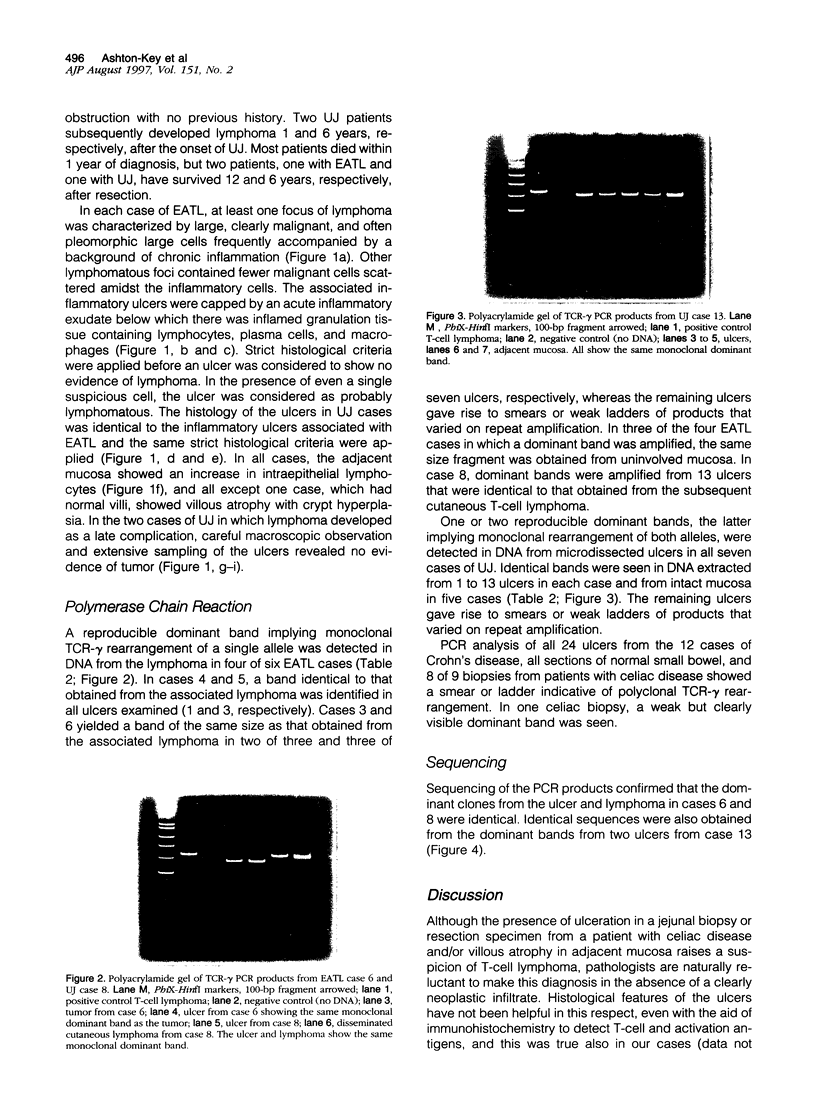Abstract
Ulcerative jejunitis (UJ) and enteropathy-associated T-cell lymphoma (EATL) are closely related conditions both associated with celiac disease. Benign-appearing inflammatory ulcers are seen in both, which has led to the suggestion that UJ is a manifestation of EATL. The aim of this study was to investigate this relationship using the polymerase chain reaction (PCR) to detect T-cell gene rearrangement. PCR amplification of the T-cell receptor gamma-chain gene was performed on DNA extracted from lymphoma, associated inflammatory ulcers, and intervening mucosa in six EATL cases and from ulcers and intervening mucosa of seven cases of UJ. In two of these cases, DNA from a subsequent lymphoma was also studied. The PCR products from the tumor and an ulcer from one EATL case, two ulcers from one case of UJ, and one ulcer and subsequent cutaneous lymphoma from one UJ case were sequenced. Twenty-five ulcers from twelve cases of Crohn's disease, twenty sections of normal bowel, and nine celiac biopsies were included as controls. A monoclonal T-cell population defined by a dominant band equal in size to that amplified from the lymphoma was identified in at least one ulcer from four informative EATL cases and from intervening mucosa in three. Monoclonality was demonstrated in at least one, and up to thirteen, ulcers from all seven cases of UJ, in intervening mucosa in five, and in the two subsequent lymphomas. Sequencing showed the same clone was present in the tumor and the ulcer in the EATL case, in two of three ulcers from the UJ case, and in an ulcer and subsequent cutaneous lymphoma in one UJ case. All Crohn's disease ulcers and all sections of normal bowel were polyclonal. One of nine celiac biopsies showed a dominant band. In conclusion, we have shown that T-cell monoclonality is a feature of the ulcers in both UJ and EATL and that the same clone is present in EATL and its associated inflammatory ulcers and in UJ and subsequently developing lymphoma.
Full text
PDF





Images in this article
Selected References
These references are in PubMed. This may not be the complete list of references from this article.
- Alfsen G. C., Beiske K., Bell H., Marton P. F. Low-grade intestinal lymphoma of intraepithelial T lymphocytes with concomitant enteropathy-associated T cell lymphoma: case report suggesting a possible histogenetic relationship. Hum Pathol. 1989 Sep;20(9):909–913. doi: 10.1016/0046-8177(89)90105-6. [DOI] [PubMed] [Google Scholar]
- Algara P., Soria C., Martinez P., Sanchez L., Villuendas R., Garcia P., Lopez C., Orradre J. L., Piris M. A. Value of PCR detection of TCR gamma gene rearrangement in the diagnosis of cutaneous lymphocytic infiltrates. Diagn Mol Pathol. 1994 Dec;3(4):275–282. doi: 10.1097/00019606-199412000-00011. [DOI] [PubMed] [Google Scholar]
- Bayless T. M., Kapelowitz R. F., Shelley W. M., Ballinger W. F., 2nd, Hendrix T. R. Intestinal ulceration--a complication of celiac disease. N Engl J Med. 1967 May 4;276(18):996–1002. doi: 10.1056/NEJM196705042761802. [DOI] [PubMed] [Google Scholar]
- Blumberg R. S., Yockey C. E., Gross G. G., Ebert E. C., Balk S. P. Human intestinal intraepithelial lymphocytes are derived from a limited number of T cell clones that utilize multiple V beta T cell receptor genes. J Immunol. 1993 Jun 1;150(11):5144–5153. [PubMed] [Google Scholar]
- Diss T. C., Pan L., Peng H., Wotherspoon A. C., Isaacson P. G. Sources of DNA for detecting B cell monoclonality using PCR. J Clin Pathol. 1994 Jun;47(6):493–496. doi: 10.1136/jcp.47.6.493. [DOI] [PMC free article] [PubMed] [Google Scholar]
- Diss T. C., Watts M., Pan L. X., Burke M., Linch D., Isaacson P. G. The polymerase chain reaction in the demonstration of monoclonality in T cell lymphomas. J Clin Pathol. 1995 Nov;48(11):1045–1050. doi: 10.1136/jcp.48.11.1045. [DOI] [PMC free article] [PubMed] [Google Scholar]
- Isaacson P., Wright D. H. Malignant histiocytosis of the intestine. Its relationship to malabsorption and ulcerative jejunitis. Hum Pathol. 1978 Nov;9(6):661–677. doi: 10.1016/s0046-8177(78)80049-5. [DOI] [PubMed] [Google Scholar]
- Jewell D. P. Ulcerative enteritis. Br Med J (Clin Res Ed) 1983 Dec 10;287(6407):1740–1741. doi: 10.1136/bmj.287.6407.1740. [DOI] [PMC free article] [PubMed] [Google Scholar]
- McCarthy K. P., Sloane J. P., Kabarowski J. H., Matutes E., Wiedemann L. M. A simplified method of detection of clonal rearrangements of the T-cell receptor-gamma chain gene. Diagn Mol Pathol. 1992 Sep;1(3):173–179. [PubMed] [Google Scholar]
- Mills P. R., Brown I. L., Watkinson G. Idiopathic chronic ulcerative enteritis. Report of five cases and review of the literature. Q J Med. 1980 Spring;49(194):133–149. [PubMed] [Google Scholar]
- Murray A., Cuevas E. C., Jones D. B., Wright D. H. Study of the immunohistochemistry and T cell clonality of enteropathy-associated T cell lymphoma. Am J Pathol. 1995 Feb;146(2):509–519. [PMC free article] [PubMed] [Google Scholar]
- Pan L. X., Diss T. C., Peng H. Z., Isaacson P. G. Clonality analysis of defined B-cell populations in archival tissue sections using microdissection and the polymerase chain reaction. Histopathology. 1994 Apr;24(4):323–327. doi: 10.1111/j.1365-2559.1994.tb00532.x. [DOI] [PubMed] [Google Scholar]
- Robertson D. A., Dixon M. F., Scott B. B., Simpson F. G., Losowsky M. S. Small intestinal ulceration: diagnostic difficulties in relation to coeliac disease. Gut. 1983 Jun;24(6):565–574. doi: 10.1136/gut.24.6.565. [DOI] [PMC free article] [PubMed] [Google Scholar]
- Wright D. H., Jones D. B., Clark H., Mead G. M., Hodges E., Howell W. M. Is adult-onset coeliac disease due to a low-grade lymphoma of intraepithelial T lymphocytes? Lancet. 1991 Jun 8;337(8754):1373–1374. doi: 10.1016/0140-6736(91)93059-i. [DOI] [PubMed] [Google Scholar]
- de Bruin P. C., Kummer J. A., van der Valk P., van Heerde P., Kluin P. M., Willemze R., Ossenkoppele G. J., Radaszkiewicz T., Meijer C. J. Granzyme B-expressing peripheral T-cell lymphomas: neoplastic equivalents of activated cytotoxic T cells with preference for mucosa-associated lymphoid tissue localization. Blood. 1994 Dec 1;84(11):3785–3791. [PubMed] [Google Scholar]





